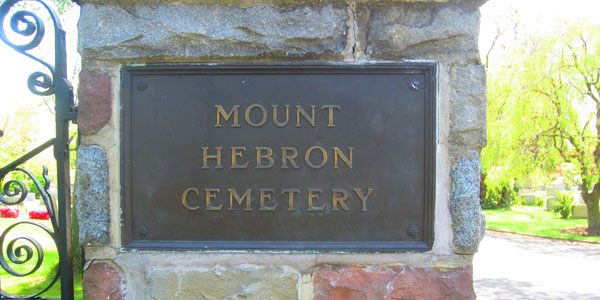The Civil War was at its height in February 1863. The great battles of Bull Run, Antietam, Fredericksburg and Shiloh had been fought, with more desperate encounters to come. Among the Union troops were boys from the Northern New Jersey villages of Cranetown and Speertown (later to be known as Montclair and Upper Montclair). Some were to return home, others were buried in the battlefields where they fell.
In those times relatively few small towns had cemeteries as we know them today. Country people usually interred their departed in local church graveyards or in private burial plots on their farms. Most of the Speertown farmers were descendants of Hollanders who earlier had trekked westward from New York (then New Amsterdam) and settled near the Indian trading post of Acquackanock (now Clifton) near the Passaic River and laid out their farms in parallel strips along the northern Newark border of the Watchung Mountain line. Here the came in contact with the Puritan settlers who had established themselves in Cranetown.
Show me the manner in which a nation cares for its dead and I will measure with mathematical exactness the tender mercies of its people, their respect for the laws of the land, and their loyalty to high ideals.
William Ewart Gladstone
The need for a centrally located cemetery of ample size and appropriate character was the subject of discussion by a group of leading citizens of Cranestown and Speertown who met on the night of February 28, 1863 and decided to form The Mount Hebron Cemetery Association.
Attending the meeting were: Peter G. Speer, Thomas C. Van Riper, Aaron Sigler, John Hayden, Stephen Ennis, Moses S. Crane, Thomas Vernon, Starr Parsons, Reynier Speer, Harvey Crane, William R. Jacobus, George Ennis, Job Sigler, and Cyrus Parsons.
The original minutes of this meeting are still preserved intact in the cemetery’s archives and from then we learn that the founders agreed to: “Form an association for the purpose of producing and holding lands to be used exclusively for a cemetery or place for the burial of the dead…and that the name of the association shall be The Mount Hebron Cemetery Association”.

With the founders named as trustees, The Mount Hebron Cemetery Association was officially incorporated under the Rural Cemetery Act, on March 3, 1863, before Wm. Silas Whitehead, master-in-chancery of Essex County, New Jersey. The property selected for cemetery purposes consisted of two and one-half acres of the farm of Peter G. Speer, after whose family Speertown was named. The southern boundary was the so-called Mount Hebron Crop Road from which the cemetery derives its name. To the west of the plot lay Valley Road which from Revolutionary days had been the main thoroughfare connecting Essex and Passaic counties. The armies of George Washington and the British had traveled this historic road nearly a century before.
As needed, additional land for cemetery purposes was acquired over the years until in 1900 the grounds had grown to about 18 acres. In 1923 another tract of 12 acres was purchased from Peter S. Van Reyper so that today Mount Hebron Cemetery, nestling in the foothills of the Watchung Mountain Range and overlooking the countryside toward the skyline of Manhattan, consists of some 30 acres of beautifully landscaped grounds. It is efficiently managed by a competent Board of Trustees elected by the lot owners, and has been chosen as a final resting place for thousands of families whose homes are in the area.